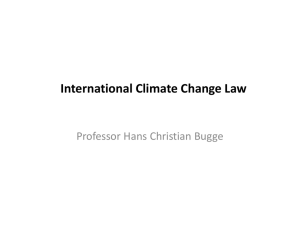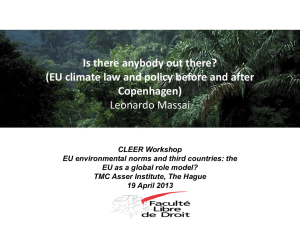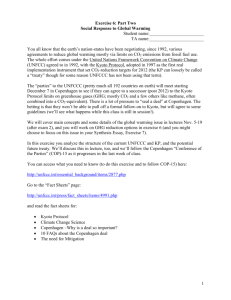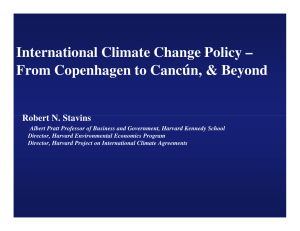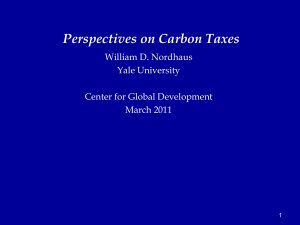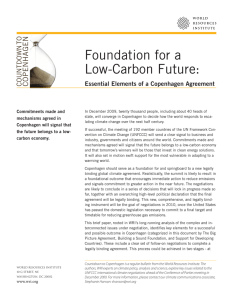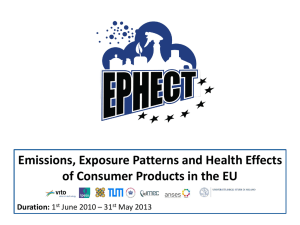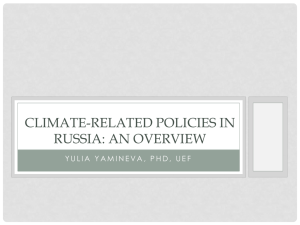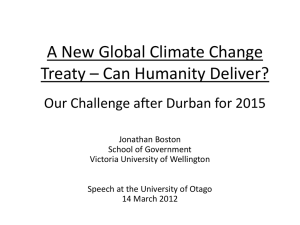Parson Presentation - Centre for International Governance
advertisement
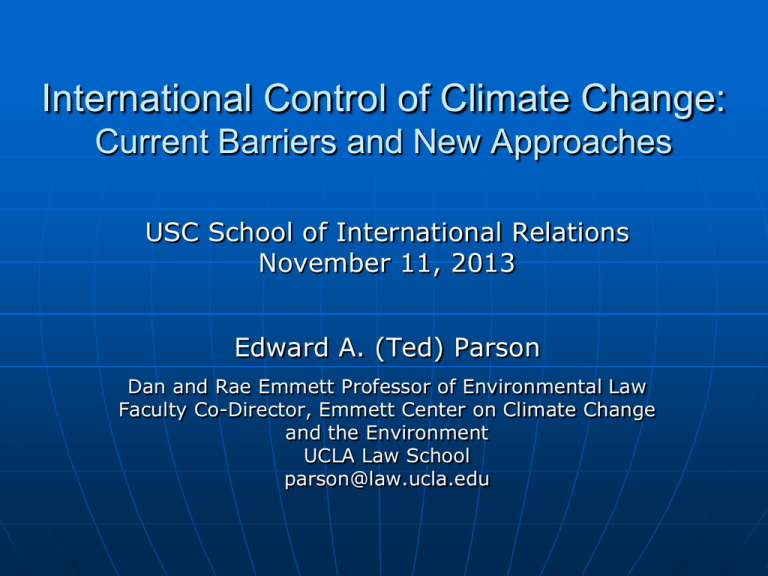
International Control of Climate Change: Current Barriers and New Approaches USC School of International Relations November 11, 2013 Edward A. (Ted) Parson Dan and Rae Emmett Professor of Environmental Law Faculty Co-Director, Emmett Center on Climate Change and the Environment UCLA Law School parson@law.ucla.edu Climate change: Five things we know 1. The Earth is heating up – rapidly 2. Human emissions of CO2, other gases, are the dominant cause 3. Changes will continue and probably accelerate 4. Impacts? • • 5. Diverse, Variable, Uncertain, Less well understood Plausible outcomes range from “no big deal” to “civilization-threatening catastrophe” Most recent new is bad … Disconnect between popular perception and reality is vast and growing. Scientific uncertainties: Real, some large, but DO NOT undermine these points Recent political attacks on climate science have raised NO points that deny or significantly modify this knowledge What to do about it? Three types of response • Limit climate change by reducing net emissions • Adapt to changes we can’t avoid by reducing vulnerability (and back on the agenda after a long absence …) • Engineer the Climate: modify global processes to unlink emissions and climate change. 1. Limit climate change by cutting emissions A global problem: Must limit world emissions A century-scale problem: Start now, sustain through slow transition to non-fossil energy system: Steering a supertanker Many feasible options, available and in the pipeline (All needed – no magic bullet, no pre-exclusions) Innovation not enough – need massive deployment Not enough “no regrets” options – Need Incentives from policy and law How much must we cut to limit risks? Avoid most severe impacts of climate change ~↓ (approx expert judgments) Limit global-average Δ T to ~ 2 º C (now ~ 0.8) ~↓ (~ 50% chance) Limit atmospheric GHGs to ~ 450 ppm CO2-eq (now ~ 400) ~↓ (pretty confident) Cut world emissions 50 – 85% by 2050 ~↓ (political judgment and bargaining) Cut emissions in rich countries at least 80% by 2050 Policies to Achieve Emission Cuts • Economy-wide measures to put a price on emissions • Emission taxes, tradable permits, or combinations • Start modestly, increase stringency over time –clear signal to new investment • Support for energy R&D • Targeted sectoral measures • Where energy market incentives are weak • For large near-term targets of opportunity • Large government decisions: e.g., infrastructure, • Plus … processes for adaptation and learning as we go International Climate Law Major landmarks • Framework Convention (1992) • Principle of Common but Differentiated Responsibility • Defined “Annex 1” countries (ICs plus former Soviet bloc) • Kyoto Protocol (1997) • • • Modest near-term emission limits for Annex 1 countries Defined on basket of 5 gases, 2008-2012 Compliance range: from squeaker (EU) to train wreck (Canada) International Climate Law Recent efforts • Bali (2007) • • • Copenhagen (2009) • • • First undertaking for mitigation “actions” by non-Annex 1 Two negotiating tracks: Kyoto (for parties), LCA (for all) Deadlock, procedural blockage (again) Last-minute political accord – significant advances, but far short of need Post-Copenhagen fizzle: Cancun, Durban, Doha, Warsaw (starting today) • • • • Durban program: negotiate new instrument by 2015, in force by 2020 Doha: establish (fictitious) KP 2nd commitment period, abolish two Bali tracks Overt collapse avoided each year, but ~ zero progress Prospects so dim, Saudi Arabia has refrained from further procedural obstruction The Current Deadlock: Summary UNFCCC/Kyoto Process: Universality + formal procedures + consensus decision-making = deadlock National Actions: • • • • • • US: Legislation blocked since 2010, no current prospects Executive action: EPA regulation under Clean Air Act, etc. EU: Early leadership, strong targets, implementation failure Signs of strong action in emerging economies, esp. China Sub-national: California, British Columbia, Regional efforts Nothing remotely proportional to the needs Science: • IPCC – New assessment coming, influence declining • Political campaign against climate science is winning Dangerous “New line” in debate (not new) • “Tech Breakthrough” school without incentives – magical thinking Ways Forward? Shift from UN Universality back to Great-Power Diplomacy? • Old heresy ~ new consensus: 12 to 20 at the table: Major Economies, G8+5 – G-20 • Long-standing informal practice in larger forums (until Copenhagen) • Several Track II exercises mapped potential “global bargain” • Needs: Heads of Govt, broad agenda, institutional continuity, support • Biggest challenges: burden-sharing, implementation and MRV • Reality-check: Promising direction, but no serious action yet in these Attention-forcing event: • • • Serious debate on Geoengineering: • • More evident disruptions More pressure for Action But what type of event? (Nothing so far has done it) With what result: Flip from nothing to panic, search for blame? Wild-card: Politically toxic now, may be essential Big benefit, big risk: Will need international governance The Chinese Solution: • • Chinese Empire solves the problem in 50 years Our fecklessness (on this and other issues) has made us irrelevant Ways Forward? Private “smart-money” leadership • Not enough by itself … but might set off virtuous circle: what innovations can get toe-hold, expand rapidly enough? • Most likely: some technologies grow rapidly, some people get very rich, but small contribution to problem (but what’s the alternative?) Small policies (California, etc.) • Not enough … but might set off a virtuous circle • Interaction between small policies and smart-money leadership – more promise than either alone Serious action by a small group (2 to 20)? Three Challenges • Allocation of efforts, burdens within group Any viable group will include wide GDP/cap range • Burden-sharing can be implicit but can’t be avoided • • Monitoring and verification of commitments • • Sharpest conflict, most progress at Copenhagen Emissions leakage Policies raise costs Energy-intensive production moves • Lose competitiveness and employment, weaken envt goal • Size, speed may be over-stated, but still real concern • Response to Emissions Leakage • Make the group bigger • Embed incentives for rapid expansion • • Anticipated expansion weakens incentive for investment shift Enact border adjustment measures • Assess embedded emissions in traded goods • Charge equivalent policy burden on imports, Rebate on exports • Easy for fuels, harder for emissions-intensive products • In US legislation, EU proposals • WTO-permissible? • • • • • Not yet attempted, challenged, or adjudicated – but probably … Easier in context of MEA (how many?) Depends on form of policy (Carbon tax, Cap-trade, Sectoral?) No trickery in design or implementation Procedural recourse Extra Slides Atmospheric CO2: Direct measurements since 1958 The Earth is heating up: 100-year history (NASA GISS) Recent heating in 2000-year context (Copenhagen Diagnosis, 2009) Northern Hemisphere reconstructed temperature change since 200AD Projected Temperature: Next 100 vs. Past 1500 years Emission Scenarios for Stabilization 2. Adapt to Unavoidable Changes to Limit Harm A Multi-scale problem, from local/regional to global Ironies of adaptation: • Long-standing conspiracy of silence • Common presumption it’s easier – with no evidence Adapting, Limiting are Linked: Limit less Must adapt to more Necessary, sure … but Easy? • Current evidence – Mal-adaptation even to current conditions • Serious adaptation – Multiple hard legal/political problems Build robustness to variable conditions Higher costs Zoning, Planning, other limits on development Manage and pool risks: Public insurance, emergency prep, public health Reducing vulnerabilities: Resource transfers, domestic and international 3. Engineer interventions to limit climate change • Two ways: alter Carbon cycle, or Sunlight – High vs. Low leverage • Fast: Cool Earth ~ 1 year, vs. decades for mitigation or C-capture • Cheap: Offset 21st-C heating for ~ $Bn/year, dropping – call it zero • Imperfect: Direct environmental harms (the least of the problems?) Imperfect climate offset: • Global-average: Temperature vs. water • Regional and seasonal effects • Achieve regional tuning? Oops, it’s a weapon Non-climate effects of CO2: oceans, ecosystems • Sharp dilemma: Raise big new risks, but we might need them • Governance and control? Severe challenges to Law and Institutions How to cut emissions this much? • Transform world energy system to climate-safe sources in ~ 100 years • Climate-safe technologies? the usual suspects • Available now (but much room for advances) • • • • • More distant prospects (but plausible over decades) • • • Efficiency (huge room for improvement) Renewables (incl. biofuels and geothermal) Nuclear fission Carbon capture and storage (extends usable lifetime of fossil fuels) Space solar Nuclear fusion Cost? • • Stabilize 450 ppm: ~ 1-10% future loss (from baseline 7-15X real growth by 2100) Marginal costs: ~ $200-2,000 per tonne Carbon Climate Change Response: Framework Convention on Climate Change (1992) ~ All nations are parties, including USA Ratified by Bush Sr. administration Broad structure for subsequent management, no concrete commitments Objective: “… stabilization of greenhouse gas concentrations in the atmosphere at a level that would prevent dangerous anthropogenic interference with the climate system … ” Various Principles, including “Common but Differentiated Responsibility” Defines classes of parties (mainly Annex 1 vs. non) for distinct obligations – a rigidity now problematic Weak hortatory target for Industrialized countries: back to 1990 emissions levels in 2000 (almost none met it, no consequences) Climate Change Response: Kyoto Protocol (1997) 1995 Berlin mandate set agenda: QERLOs for Annex 1 Parties as first step ~ 190 parties (USA only significant non-Party) Key implementation questions resolved in Bonn (2001) Entered into force Feb 2005, after Russian rat’n achieved 55% threshold Binding emission targets for developed countries, avg. 5.2% below 1990 • EU 8%, Japan, Canada 6%, Russia 0%, USA 7% • Defined over 2008-2012 commitment period • For weighted “basket” of 6 greenhouse gases Flexibility mechanisms: What, when, where – US pushed Emissions trading – Concern with Russian “hot air” Domestic implementation not specified; Self-reporting of national performance Kyoto Protocol: Progress and Problems, 1997-2007 Hypnotized by numbers, last-minute horse-trading (incl. reversal of domestic deals in US, Canada) Key implementation issues deferred – mostly resolved 2001, but … • Substantial weakening • Lost the US (if they ever had it), no chance for re-engagement Late entry into force, political weakness: Most will miss 1stround targets • Formal success overall depends on massive credit from Russia “hot air” Targets: too strong now (high costs), nothing long-term when it matters ~ No progress on further cuts post-2012: negotiations obstructed by front-loading debts from 1st-round exceedence ~ No progress engaging Developing Countries on future emissions commitments until Bali, 2007 … Bali Mandate, 2007: (Episode IV: A New Hope?) Major DCs: First acceptance of responsibility for action New structure to negotiate commitments: IC “commitments” vs. DC “actions” – First step to reengage USA Two tracks to Copenhagen: AWG-LCA and AWG-KP But … (Episode V: The Empire Strikes Back?) Immediate return to deadlock: Tracks separate or linked? No progress through mid-2009, lowering expectations: Copenhagen 2009: Revealing the Limits of Universality Key Issues: • • • • • Further IC emission commitments DC mitigation actions Short and long-term finance Governance structures Misc issues: REDD, bunkers, etc. Proposals for new Protocols Procedural blockage Informal groups – progress only on REDD (solvable with $) “Danish text” proposals angrily (disingenuously) rejected Last-day head-of-govt negotiations: 5 nations, then 28 “Copenhagen Accord” Copenhagen Accord Another non-binding “political agreement” (as expected) Several significant advances: • • • • • Sought, but missing: • • • Explicit statement of existing IC 2020 targets Date of peak global emissions, explicit target for DCs MRV: “Unsupported” DC actions have only domestic MRV, with “International consultation and analysis” Intense final-night plenary: • • • • States 2°C warming target Emission cuts to do this: 1990 – 50% globally by 2050, “at least 80%” by ICs Careful provisions for MRV (biggest US-China conflict, biggest advance) Large increase in $: $10B/yr, 2010-2012, $100B/yr (multiple sources) from 2020 Review by 2016: Consider tightening target to 1.5°C Denounced by several nations (incl Sudan, probably China proxy) – blocked adoption “Took note” – Individual registration of support, commitments (most big have) Status as basis for future negotiations – to be contested Broader negotiations under FCCC and KP tracks remain blocked Follow-up: • • ~ 140 nations “indicated support” for Copenhagen accord ~ 80 “provided info on” emission reduction targets or other mitigation actions (Nothing new) Cancun 2010 Reprise of conflicts, obstructions, from Copenhagen (at lower volume) Relationship between KP (rich) and LCA (everyone) • Japan “bombshell”: Won’t Inscribe its existing commitments in amended KP Annex B Accept decision to extend first KP commitment period or establish a second I.e., Merge the tracks, discuss commitments for everyone together DCs have consistently refused in FCCC/KP discussions Issue by Issue: progress and importance perfectly correlated (negative) • More promising: Adaptation, technology, capacity-building And REDD … (Remains a N-S conspiracy to fake progress) • Less promising: Mitigation, Finance, MRV, Legal form (all the big ones) • Maybe we’ll get HFC controls under the Montreal Protocol … How dim are the prospects? • So dim, Saudi Arabia didn’t bother to exercise its usual procedural obstruction Managing Climate Change: Easy or Hard? A Paradox Easy: • Not the end of rich industrialized democratic societies • Just (mostly) a technical problem: how we get, convert, and use energy • Cost of major (not total) risk reduction: ~ 0.1 – 2% loss of future (very high) GDP Hard: • • • • • Scientific uncertainty and disagreement … Which can’t readily be characterized in decision-relevant terms And which is widely subject to partisan misuse E.g., What’s the probability distribution of climate-sensitivity? Inability of science (alone) to define “policy-relevant” questions • Distribution of costs – Losers (thus far) able to block • Ability to deploy ideology and symbolism to resist change (especially but not exclusively in the US)
